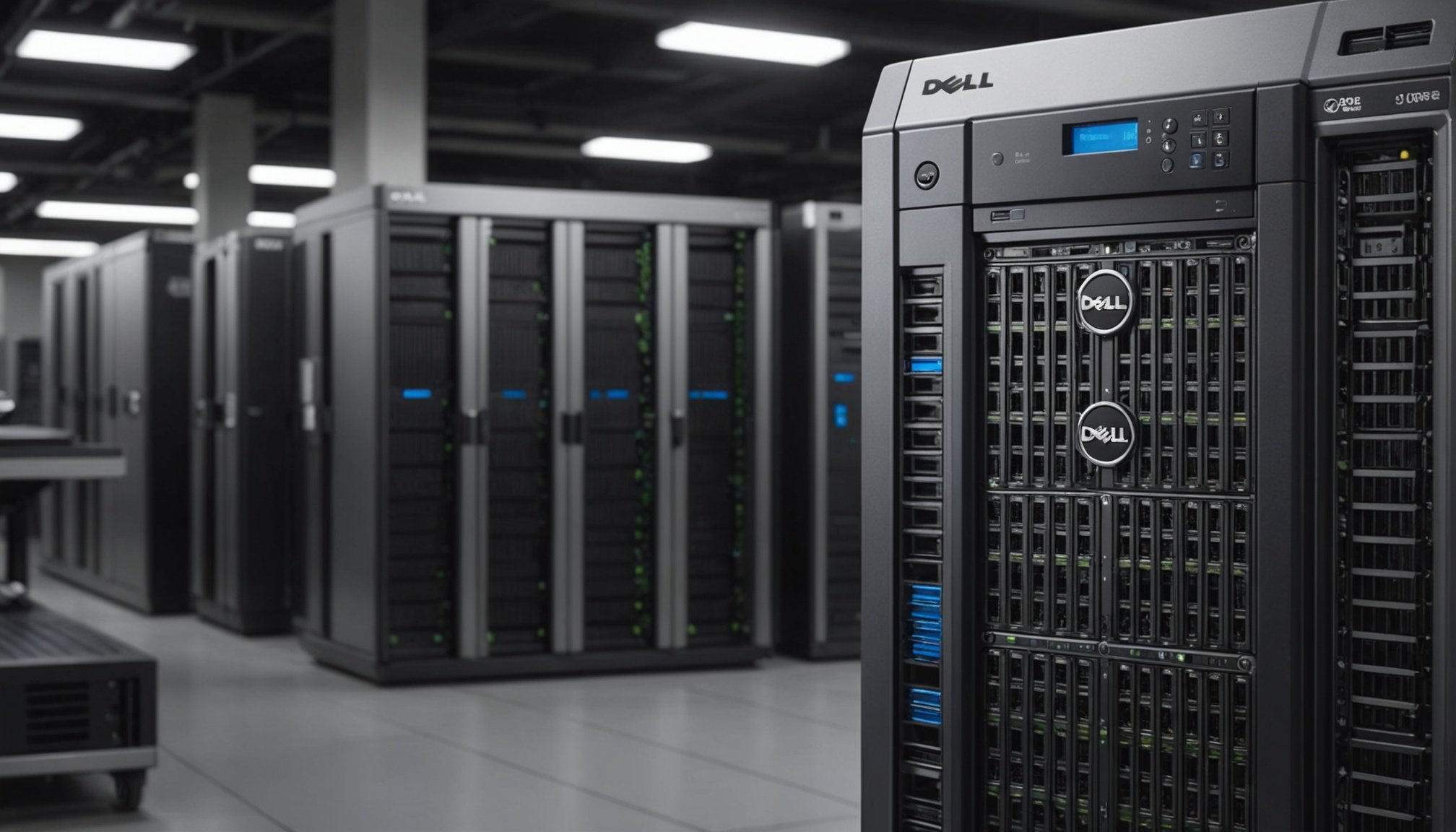Understanding the Dell PowerEdge T340
The Dell PowerEdge T340 is designed to help businesses manage a wide array of demanding workloads. Equipped with robust hardware features, this server provides a reliable foundation for various applications and services. At the heart of its appeal are its impressive server specifications, including options for scalable storage and processing power, catering to small to medium-sized enterprises.
One notable feature of the Dell PowerEdge T340 is its support for advanced data transfer capabilities. Businesses often find upgrading network components essential to performance and network capabilities. Enhancing network infrastructure allows for faster data exchanges, reducing bottlenecks and improving efficiency.
Also to discover : Ultimate Blueprint for Building a High-Performance 3D Rendering Workstation with AMD Threadripper 3960X
Key Features and Capabilities
- Hardware Features: The T340 comes with a choice of Intel processors and a flexible RAID controller, offering tailored performance.
- Scalability: Supports up to 64 GB of memory, allowing for significant growth and expansion.
- Data Transfer Optimization: Ensuring your server can handle modern workloads means considering network upgrades.
Improving your network infrastructure, particularly through upgrades like a 10GbE network card, can significantly enhance performance. Faster data transfer capabilities are increasingly vital, ensuring the Dell PowerEdge T340 remains a reliable, high-performing solution in evolving business environments. Consider these factors when looking to optimize your server’s capabilities.
Compatibility of 10GbE Network Cards with Dell PowerEdge T340
Ensuring your Dell PowerEdge T340 can fully leverage a 10GbE network card upgrade requires checking 10GbE compatibility. The hardware requirements are critical, and this server model supports several compatible 10GbE cards, optimising performance with the right upgrades.
In parallel : Maximize Gaming Performance Affordably: Essential Tips to Enhance Your Dell Inspiron 5502
Firstly, confirm that the T340’s PCIe slots are compatible with your chosen 10GbE network card. It’s essential to choose a card designed for rack-mountable servers to avoid hardware compatibility issues. Ensure that the card fits both physically and electronically.
Installing a 10GbE network card requires updating the server’s firmware and ensuring that drivers are compatible with your operating system. Look for the manufacturer’s latest versions, which guarantee hardware is functioning seamlessly. Regularly updated drivers are particularly important for maintaining network stability and support for new features.
Finally, before installation, ensure to verify the firmware compatibility to avoid conflicts that might degrade performance. Firmware often dictates how well the card can communicate with the Dell PowerEdge T340. Thoroughly consulting the server and card manufacturer’s guidance can prevent potential mismatches.
By carefully considering these hardware requirements, you can ensure a smooth installation and significant performance improvements from the 10GbE upgrade.
Step-by-Step Installation Guide
Proper installation of a 10GbE network card is crucial to fully optimize your Dell PowerEdge T340. The following steps will guide you through the process efficiently.
Preparing for Installation
Before installing, ensure you have completed a preinstallation checklist: verify 10GbE compatibility and gather all necessary tools, such as a screwdriver and antistatic wrist strap, to avoid damaging any components. Ensure you have updated your server’s firmware and secured compatible drivers for seamless integration.
Installing the 10GbE Network Card
Start by powering down the Dell PowerEdge T340 and unplugging all cables. Remove the server’s side panel to access the PCIe slots. Carefully insert the 10GbE network card into an available slot, fastening it securely to prevent any potential movement. If additional support brackets are included, ensure these are also used to stabilize the card.
Configuring the Network Settings
Once the physical installation is complete, reconnect the power and boot up the server. To configure network settings, access the server’s BIOS and ensure the card is recognized. Adjust any necessary settings within your operating system to finalize the configuration. This setup will optimize the network efficiency and ensure maximum performance benefits from your upgrade.
Troubleshooting Common Issues
Installing a 10GbE network card in your Dell PowerEdge T340 might present some challenges. Knowledge of common issues is essential for effective troubleshooting.
Identifying and Resolving Installation Issues
During installation, physical fit is paramount. Ensure all connections are secure, and verify that the card is correctly seated in its PCIe slot. Loose connections often lead to unresponsiveness. If issues persist, re-evaluate compatibility; not all 10GbE cards suit every server model.
Addressing Performance Discrepancies
After setup, performance discrepancies could arise. Check your 10GbE compatibility by ensuring your drivers and firmware are updated. Incorrect configurations can limit network speeds. Proper settings often require reviewing your server’s BIOS and making necessary adjustments for optimal data transfer rates.
Resources for Technical Support
For unresolved problems, leveraging technical support is advantageous. Manufacturer websites frequently provide comprehensive guides and updates. Online forums can also offer peer support from those with similar 10GbE network card experiences. If formal support is necessary, contact the manufacturer directly to access specific solutions tailored to the Dell PowerEdge T340. Engaging with community resources could reveal insightful troubleshooting tips that expedite resolution.
Importance of 10GbE Network Cards
Upgrading to a 10GbE network card in the Dell PowerEdge T340 can transform your server’s capabilities by boosting network performance significantly. The benefits of 10GbE extend beyond speed—offering a quantum leap over standard Ethernet in data-heavy environments.
Advantages of 10GbE Network Cards
10GbE enhances data transfer rates, meaning large files, media streaming, and data backups happen faster. This increased throughput is crucial for businesses handling significant data volumes or running applications needing high bandwidth.
Comparison with Standard Ethernet
Standard Ethernet options typically max out at 1Gbps, limiting intense data operations. In contrast, 10GbE network cards provide tenfold speed, maintaining performance even under demanding workloads. This difference is evident in real-time data processing where latency matters, making 10GbE essential for competitive businesses.
Impact on Server Environments
Incorporating 10GbE in server environments reduces data bottlenecks, ensuring streamlined operations. Immediate performance boosts manifest in quicker database queries and faster access to shared resources, fostering an efficient ecosystem.
Deploying a 10GbE network card aligns with future-proofing strategies, satisfying escalating network demands. By integrating this technology, the Dell PowerEdge T340 remains robust against rising digital workloads.
Optimization Tips for Enhanced Performance
Maximizing the performance of your Dell PowerEdge T340 after installing a 10GbE network card requires strategic network optimization. These tips will ensure network efficiency and unlock the full potential of your server.
Firstly, network configuration settings should be adjusted meticulously. Ensure that jumbo frames are enabled to help in reducing CPU load during data transfers. This adjustment enhances throughput by allowing larger packets, thereby improving network efficiency.
Integrating Quality of Service (QoS) policies can prioritize critical traffic like video conferencing or data backups, effectively managing bandwidth and reducing latency. Consider configuring port prioritization to optimise data flow where it’s most needed.
Utilizing software tools for monitoring is invaluable. Tools like SNMP monitoring can provide real-time insights into traffic patterns and potential bottlenecks. These insights help in proactively managing and adjusting network settings to maintain optimal performance levels.
Moreover, periodic network assessments can help identify emerging inefficiencies or hardware wear, allowing for timely corrective measures. Scheduling regular network maintenance and updates ensures the network’s robustness, maintaining the 10GbE card’s peak performance.
Applying these optimization techniques with rigor can lead to noticeable improvements in your server’s network performance, directly benefiting business operations.
Performance Comparison
Understanding how data transfer rates are impacted by upgrading to a 10GbE network card in the Dell PowerEdge T340 is essential for optimizing server performance. When comparing 10GbE vs standard Ethernet options, the former can increase speeds by up to tenfold, with standard Ethernet typically capping at 1Gbps. This marked improvement is critical for businesses managing substantial data loads.
Benchmarking data transfer rates before and after installation reveals the tangible benefits of 10GbE upgrades. Pre-installation benchmarking provides a baseline of current performance, which can be dramatically surpassed once the 10GbE card is active. This difference is especially pronounced in environments with intensive data processing needs.
In real-world scenarios, leveraging 10GbE allows real-time processing, essential for applications that require low latency and high throughput. The elevated speeds enable quicker access to shared resources and more efficient workflows, thereby reducing operational bottlenecks.
Ultimately, the adoption of a 10GbE network card in server environments like the Dell PowerEdge T340 not only enhances data transfer but also contributes to a smoother, more efficient operation, underscoring the significant performance gains compared to traditional Ethernet solutions.
Conclusion and Next Steps
Upgrading the Dell PowerEdge T340 with network enhancements, particularly integrating a 10GbE network card, ensures your server’s responsiveness to rapidly evolving digital demands. Regular updates and rigorous ongoing maintenance are pivotal to preserving optimal network performance. Be diligent about keeping firmware and drivers up to date. Such routine updates prevent compatibility issues, sustaining high efficiency.
The process of future-proofing your server involves strategically planning for additional upgrades. As your business scales, flexibility in expanding storage and enhancing processing power becomes critical. Explore potential upgrades in peripheral areas like advanced RAID configurations or increased RAM, depending on workload demands.
Incorporating further networking enhancements, such as redundant network paths or implementing robust security protocols, are avenues to bolster resilience. These strategies not only protect the server from potential failures but also ensure data integrity and continuous performance improvements.
Arming your business with a Dell PowerEdge T340 customised with forward-thinking upgrades allows you to maintain an edge in competitive environments. By proactively adopting technologies that anticipate future needs, your server remains a robust foundation capable of meeting tomorrow’s challenges head-on.

